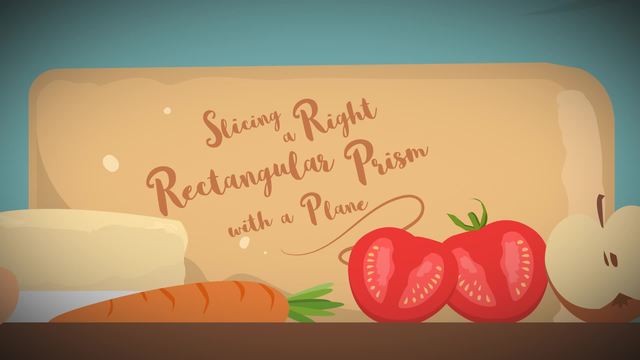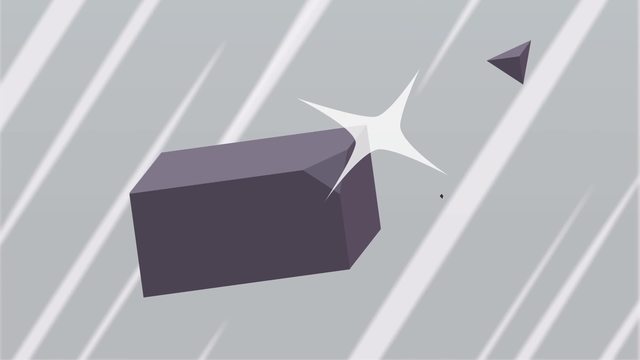Slicing a Right Rectangular Pyramid with a Plane


Basics on the topic Slicing a Right Rectangular Pyramid with a Plane
After this lesson, you will be able to describe the plane sections created by slicing a right rectangular pyramid.
The lesson begins by teaching you that slices parallel to the base result in rectangles proportional to the base. It then shows you how slices perpendicular to the base can result in trapezoids. It concludes with slices through the apex, which form isosceles triangles.
Learn about slicing right rectangular pyramids by helping Tom and Eddy divide their tent!
This video includes key concepts, notation, and vocabulary such as slicing, plane section (the 2-d figure formed by a slice), right rectangular pyramid (a figure composed of a rectangular base and 4 triangular lateral faces that meet at a point called the apex); apex (the point where the lateral faces meet--in a right pyramid the apex is over the center of the base); and trapezoid (a quadrilateral with exactly one pair of parallel sides).
Before watching this video, you should already be familiar with right rectangular pyramids, plane sections, trapezoids, and proportionality.
After watching this video, you will be prepared to learn about the plane sections formed by slices that are not parallel or perpendicular to any face.
Common Core Standard(s) in focus: 7.G.A.3 A video intended for math students in the 7th grade Recommended for students who are 12 - 13 years old
Transcript Slicing a Right Rectangular Pyramid with a Plane
Ah, there's nothing like the peaceful beauty of camping in the great outdoors. Wait a minute. It's the brothers Tom and Eddy and things are not peaceful! If they are going to share this tent they each need their own personal space. To divide their tent into two rooms, they will need to practice slicing a right rectangular pyramid with a plane. Here's their tent, which is in the shape of a pyramid. The floor, which is a rectangle, is the base of our pyramid. There are four lateral faces each of which is an isoceles triangle. The four triangles meet at a point called the apex. The apex is directly above the center of the base, so we call this a right rectangular pyramid. How can we divide this pyramid so that each brother has room to relax? We need to slice it. There are lots of ways to slice the pyramid, each of which create a plane section. What shape is created if we slice parallel to the base? That means there is a plane intersecting the pyramid. The resulting plane section is a rectangle. Depending on where we slice the pyramid, we can create smaller or larger rectangles but these rectangles will always be proportional to the base. That means the ratio of the length to the width of the plane section, is equal to the ratio of the length to the width of the base. That's pretty cool, but would this be a practical way to divide the tent? Only if you want it to be a double-decker. Another option for slicing the pyramid would be perpendicular to the base. What shape do you think will be created here? Let's rotate the pyramid to get a better look. There is exactly one pair of parallel sides so this is a trapezoid. By moving the plane we can make the trapezoid bigger or smaller. Do you think all these trapezoids are proportional to each other? Because the base on the bottom always stays the same length while the top changes they are not proportional to each other. Do you think these trapezoids are a good way to divide the tent? Only if one of the brothers is ok having the smaller room, since this slicing doesn't divide the pyramid equally. How can we divide the pyramid into equal parts? A slice through the apex perpendicular to the base! Note that when we look at the base, the slice is also parallel to two edges of it. What is the resulting plane-section? A triangle! In fact, it's an isoceles triangle, since these two sides are equal. Additionally, the height of the triangle is the height of the pyramid. An isoceles traingular curtain is a perfect solution for the brothers' tent. While Tom and Eddy are dividing their tent, let's review what we've learned. There are many ways to slice a right rectangular pyramid. We can slice parallel to the base resulting in a rectangular plane-section. We can slice perpendicular to the base and parallel to an edge of the base giving us a trapezoid unless that slice goes through the apex, which gives us an isosceles triangle. Tom and Eddy finally have their own spaces in the tent. But, wait a minute, what's that sound? With all the wildlife around, the brothers really should stick together!
Slicing a Right Rectangular Pyramid with a Plane exercise
-
Find the right rectangular pyramid
HintsA right rectangular pyramid has a rectangular base.
A pyramid has $4$ triangular sides which meet at an apex at the top.
A right rectangular pyramid has an apex directly above the center of the base.
SolutionThis is the solution as it has:
- A rectangular base
- Four isosceles triangular lateral sides
- All the lateral sides meet at the apex
- An apex directly above the center of the base
-
Finding the plane.
HintsWe can cut the pyramid parallel to the base. What shape would that form?
We can cut the pyramid perpendicular to the base. What shape does this form?
There are $3$ correct answers. What shape would we make if we cut it in half through the apex?
SolutionThere are $3$ correct answers here
- Rectangular plane when sliced parallel to the base.
- Trapezoidal plane when sliced perpendicular to the base.
- Isosceles triangular plane when sliced down through the apex.
-
Which of these words are NOT associated with the plane of a right rectangular pyramid?
HintsThink about the parts of a right rectangular pyramid first.
We are looking for key words we would not use here.
Think about the shapes the planes of a right rectangular pyramid will make.
Will it make a circle?
There are $4$ correct answers not associated with the right rectangular pyramid, some of them are associated with a circle.
SolutionThe words we would not use for the plane of a right rectangular pyramid are:
- Radius - A line in a circle running from the center to the circumference.
- Circumference - The perimeter of a circle.
- Diameter - A straight line through the center of a circle touching the circumference at both ends. ($2\times{radius}$).
- Ellipse - A regular oval shape.
The other words are associated with a right rectangular pyramid.
- Apex - The top of the pyramid
- Plane - the shape formed when we slice the shape
- Base - a rectangle at the bottom of the shape
- Lateral faces - the side triangles which meet at the apex
- Isosceles triangle - formed by the plane which cuts the shape in half from the apex to the middle of the base
- Trapezoid - a shape formed by a plane perpendicular to the base
-
Planes parallel to the base.
HintsThe two planes are proportional to each other. For example, we can see here the shorter sides are $2$ and $4$.
The scale factor is found by dividing the corresponding dimensions. For example, here the green length is twice as long as the orange one ($4\div2$). To get the missing side we divide $8$ by $2$.
In the example we calculate the missing side by dividing the longer side by the scale factor of $2$. Orange length $= 8\div2 = 4$.
The scale factor is the multiplier which helps us see how many times longer tor shorter the sides are on similar shapes.
For example, on this question the widths are $6$ and $2$. To find the scale factor we divide $6$ by $2$.
- $6 \div 2 = 3$, the scale factor is 3. Meaning, the lengths on the larger shape are $3$ times longer than the smaller one.
SolutionThe correct answer is $5$.
- The shorter sides are $2$ and $6$
- The scale factor is $6 \div 2 = 3$.
- The green length is therefore, $3$ times as long as the orange one
- To get the missing side we divide $15$ by $3$
- $15\div3 = 5$
-
Plane of a right rectangular pyramid.
HintsTo split the right rectangular pyramid in half we need to slice through the apex to the middle of the base, perpendicular to the base.
If we slice parallel to the base the two pieces will not be the same size.
We are slicing through the apex, perpendicular to the base. What shape would the plane be?
SolutionIsosceles triangle
The plane sliced down to the middle of the base through the apex cuts it exactly in half.
The trapezoid and the rectangle form planes, but do not cut the shape in half. The kite is not a plane on this shape.
-
Find the area of a trapezoid.
HintsHere is an example.
Continue to solve this example.
We use the order of operations to find the area.
- Area $= \frac{1}{2}(5 + 7) 4$
- Evaluate the bracket first.
- Area $= \frac{1}{2}\times 12 \times 4$
- Multiply them together left to right.
- Area $= 24$ Units$^2$.
SolutionHere we can see the correct matching pairs.
________________________________________
The first one has $a = 8$, $b = 10$ and $h = 3$
Using the formula:
Area $= \frac{1}{2} (a + b) h$
Area $= \frac{1}{2} (8 + 10) 3$
Area $= \frac{1}{2}\times18\times3$
Area $= 27 in^2$














